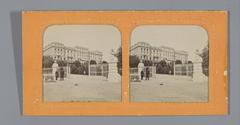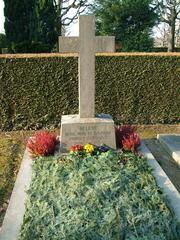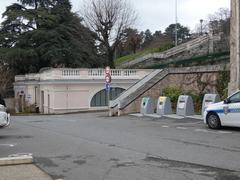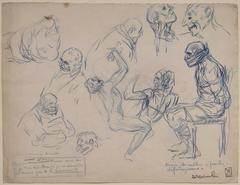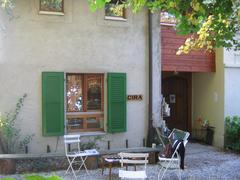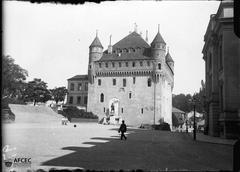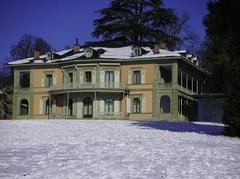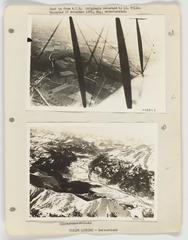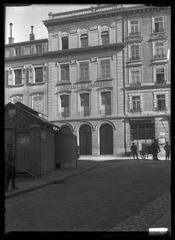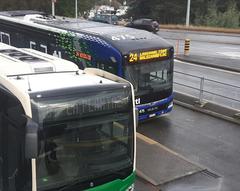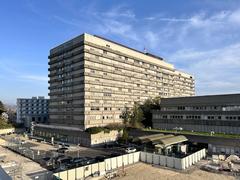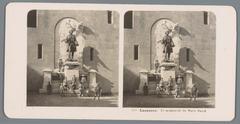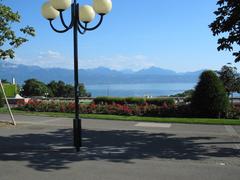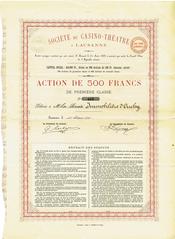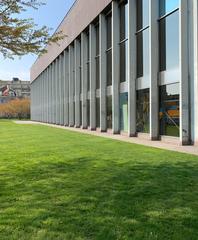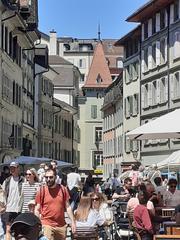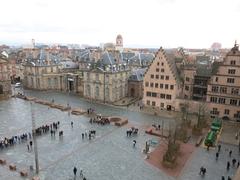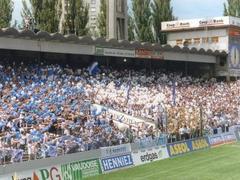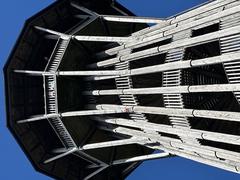
Ale Tower Lausanne: Visiting Hours, Tickets, and Historical Significance Guide
Date: 04/07/2025
Introduction
The Ale Tower (Tour de l’Ale) in Lausanne, Switzerland, is a remarkable testament to the city’s medieval past and its ongoing commitment to heritage and sustainability. This comprehensive guide covers everything you need to know about the Ale Tower, including its history, architectural significance, visiting hours, ticket information, accessibility, nearby attractions, and practical tips for a memorable visit. Whether you’re a history enthusiast, a lover of architecture, or simply exploring Lausanne’s rich cultural landscape, the Ale Tower offers a unique and enriching experience (Switzerlanding, lausanne.ch).
Table of Contents
- Introduction
- Historical Context and Significance
- Architectural Features
- Preservation and Restoration
- Visiting Information
- Accessibility and Travel Tips
- Ale Tower in Sauvabelin Forest
- Visitor Experience and Activities
- FAQ
- Conclusion
- References
Historical Context and Significance
Origins and Medieval Role
Built in the 14th century, the Ale Tower was a crucial part of Lausanne’s defensive fortifications, protecting the Faubourg de l’Ale district and the Porte de Saint-Laurent. Its cylindrical stone structure, thick walls, and defensive features were designed to withstand sieges and provide vantage points for city defenders (Switzerlanding). The tower’s name is likely derived from the nearby Rue de l’Ale, reflecting the area’s historical significance as a commercial hub.
Transformations and Preservation
During the 19th century, as Lausanne expanded, many of its medieval walls were demolished. The Ale Tower, however, survived due to proactive conservation efforts. By the late 1800s, it briefly served as a slaughterhouse. Public opposition to its demolition led to its designation as a historical monument in 1900, followed by restoration in 1903. Today, the tower stands as a symbol of Lausanne’s resilience and dedication to preserving its cultural heritage (lausanne.ch).
Cultural Importance
The Ale Tower embodies the city’s medieval roots and is featured in numerous city tours and cultural events. It’s a bridge between Lausanne’s storied past and its vibrant present, remaining an iconic emblem within the urban landscape (Lausanne Tourism Office).
Architectural Features
Medieval Defensive Design
Constructed around 1340, the Ale Tower rises approximately 21 meters and features walls up to 2.5 meters thick. Its robust cylindrical form, elevated entrance (originally accessed by ladder or removable staircase), narrow arrow slits, and crenellated summit exemplify medieval military architecture (lausanne.ch).
Construction Materials and Techniques
The tower was built with durable local stone and lime mortar. The roof, historically conical, has been restored using traditional methods to maintain authenticity and weather resistance.
Interior Layout
The interior, generally closed to the public, historically comprised multiple levels for storage, refuge, and defense. Though access inside is restricted, the exterior can be viewed year-round.
Preservation and Restoration
Conservation Philosophy and Techniques
Preservation of the Ale Tower follows European best practices, emphasizing minimal intervention and the use of traditional materials (architecturenews.io). Restoration efforts have included structural reinforcement, roof repair with historically accurate materials, non-invasive cleaning, and regular monitoring for stability and weathering (lausanne.ch).
Integration with Urban Development
Urban planning around the Ale Tower respects its historical context, preserving sightlines and integrating informational plaques and guided tours to enhance visitor understanding.
Visiting Information
Hours and Admission
- Exterior Access: Open 24 hours daily; visitors can freely view and photograph the exterior.
- Interior Access: Generally not open to the public. Special access might be available during select heritage days or guided tours (Lausanne Tourism Office).
- Admission: Viewing the exterior is free. Guided tours may require tickets.
How to Get There
- Location: The Ale Tower is situated in Lausanne’s Old Town, easily accessible on foot from Place de la Palud or Lausanne Cathedral.
- Directions: From Lausanne train station, it’s about a 15-minute walk towards the Faubourg de l’Ale district.
Accessibility
- The area is pedestrian-friendly but features some cobblestones, which may be challenging for visitors with mobility issues.
- The tower itself is not wheelchair accessible, but the surrounding streets and urban context can be enjoyed by most visitors.
Nearby Attractions
- Lausanne Cathedral: Gothic masterpiece within walking distance.
- Place de la Palud: Historic square with markets and events.
- Old Bishop’s Palace and Ancienne Académie: Additional historical sites nearby.
Ale Tower in Sauvabelin Forest
Alongside the medieval stone Ale Tower in the city center, Lausanne is also home to the modern Ale Tower (Tour de Sauvabelin) in Sauvabelin Forest.
Location and Access
- Address: Sauvabelin Forest, northern Lausanne.
- Access: Reachable by bus (Line 16 from Place de la Riponne), bicycle, or on foot. Parking is available but limited (Touringswitzerland.com).
Design and Features
- Height: 35 meters (115 feet).
- Construction: Built in 2003 by architect Julius Natterer, using locally sourced Douglas fir and larch (Swissactivities.com).
- Experience: 151-step spiral staircase leads to a panoramic observation platform overlooking Lausanne, Lake Geneva, the Alps, and Lavaux vineyards.
Hours and Admission
- Opening Hours: Typically 9:00 AM–7:00 PM in summer, until dusk in winter. Check current schedules on the official tourism website.
- Admission: Free for all visitors.
Facilities and Family Experience
- Amenities: Nearby lake, picnic areas, petting zoo, playgrounds, and a seasonal café.
- Accessibility: The tower is not wheelchair accessible, but the surrounding park and lake area are.
Visitor Experience and Activities
- Guided Tours: Available through the Lausanne tourism office for both the city center Ale Tower and Tour de Sauvabelin.
- Best Times to Visit: Early morning and late afternoon for optimal lighting and fewer crowds.
- Photography: Both towers offer excellent photographic opportunities.
- Nearby Attractions: Hermitage Park, Fondation de l’Hermitage museum, and Ouchy lakeside.
FAQ
Q: What are the Ale Tower visiting hours?
A: The medieval Ale Tower exterior is accessible year-round, 24/7. The Sauvabelin Tower is generally open from 9:00 AM to 7:00 PM in summer and until dusk in winter.
Q: Is there an admission fee?
A: Viewing the exterior of both towers is free. Guided tours may incur a fee.
Q: Are the towers accessible for people with disabilities?
A: The city center Ale Tower’s exterior is viewable via pedestrian streets but has cobblestones; the interior is not accessible. The Sauvabelin Tower is not wheelchair accessible, but the surrounding park is.
Q: How do I get to each tower?
A: The Ale Tower is in Old Town, a short walk from major landmarks. The Sauvabelin Tower is accessible by bus, bike, or foot from the city center.
Q: Are guided tours available?
A: Yes, guided tours can be arranged via the Lausanne Tourism Office.
Conclusion
The Ale Tower, in both its medieval and modern incarnations, stands as a powerful symbol of Lausanne’s heritage, architectural ingenuity, and sustainable vision for the future. Whether exploring the atmospheric streets of Old Town or ascending the panoramic heights of Sauvabelin Forest, visitors can immerse themselves in centuries of history and enjoy breathtaking views of the city and its surroundings. For the latest visiting hours, tickets, and event information, consult the official Lausanne tourism website.
For interactive guides and personalized itineraries, download the Audiala app, and follow us on social media for updates and inspiration for your Lausanne adventure.
References
- Ale Tower Lausanne: Visiting Hours, Tickets, and Historical Insights, Switzerlanding
- Ale Tower Lausanne: Visiting Hours, Tickets, Architectural History, and Preservation Guide, lausanne.ch
- Discover the Ale Tower: A Must-Visit Historical Landmark in Lausanne, Lausanne Tourist Information
- Ale Tower Visiting Hours, Tickets, and Visitor Guide to Lausanne’s Historic Tour de Sauvabelin, Touringswitzerland.com
- Ale Tower Visiting Hours, Tickets, and Visitor Guide to Lausanne’s Historic Tour de Sauvabelin, Swissactivities.com
- Federal Inventory of Swiss Heritage Sites (ISOS)
- Lausanne Tourism Office

